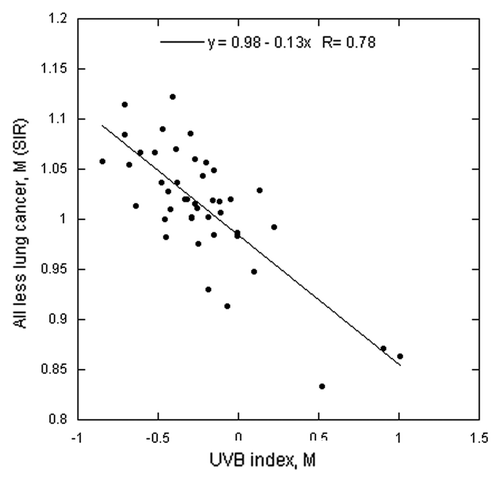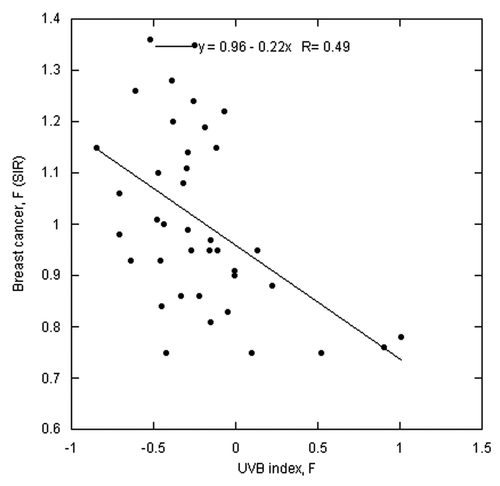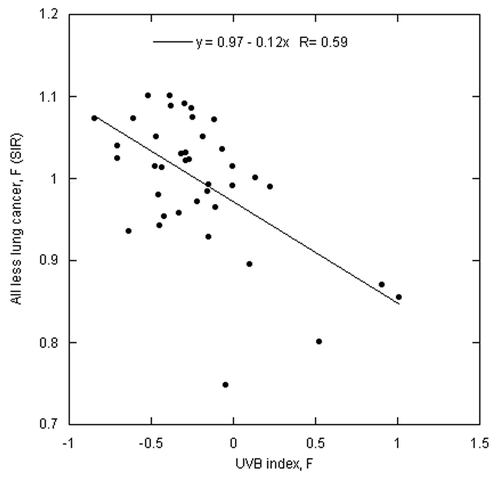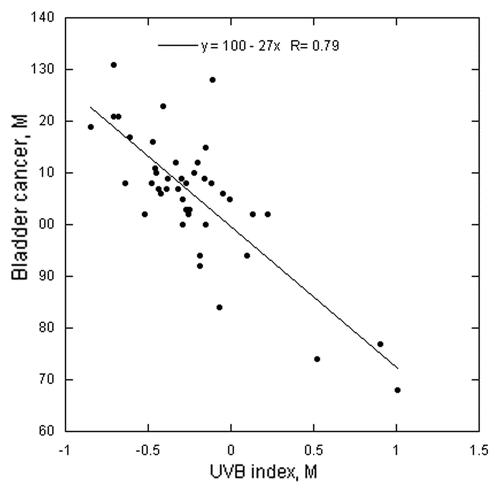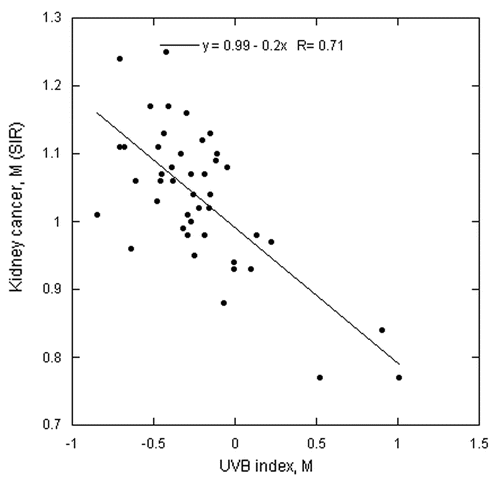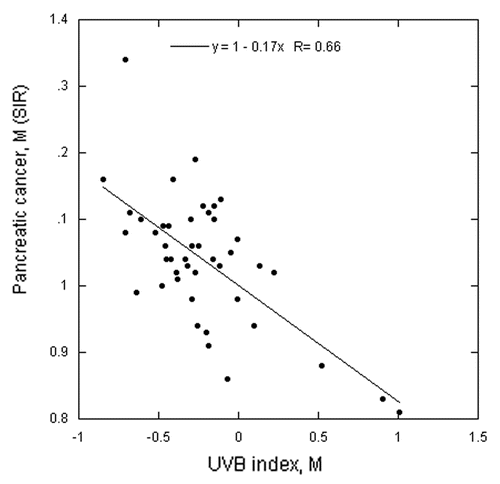Abstract
A large body of evidence indicates that solar ultraviolet-B (UVB) irradiance and vitamin D reduce the risk of incidence and death for many types of cancer. However, most of that evidence comes from midlatitude regions, where solar UVB doses are generally high in summer. Data on cancer standardized incidence ratios (SIRs) by sex and 54 occupation categories based on 1.4 million male and 1.36 million female cancer cases for 1961–2005 in the five Nordic countries provide the basis for an ecological study of the role of solar UVB in the risk of many types of cancer at high latitudes. Lip cancer SIRs less lung cancer SIRs for men was the best index of solar UVB dose, which was weakly inversely correlated with both melanoma and nonmelanoma skin cancer (NMSC) SIRs. Lung cancer SIRs were used as the index of the effects of smoking. For men, the UVB index was significantly inversely correlated with 14 types of internal cancer—bladder, breast, colon, gallbladder, kidney, laryngeal, liver, lung, oral, pancreatic, pharyngeal, prostate, rectal and small intestine cancer. For women, the same UVB index was inversely correlated with bladder, breast and colon cancer. These results generally agree with findings from other studies. These results provide more support for the UVB-vitamin D-cancer hypothesis and suggest that widespread fear of chronic solar ultraviolet (UV) irradiance may be misplaced.
The ultraviolet-B (UVB)-vitamin D-cancer hypothesisCitation1 has strong support from ecological studies,Citation2 observational studies,Citation3,Citation4 and randomized controlled trials.Citation5,Citation6 The mechanisms whereby vitamin D reduces the risk of cancer are reasonably well understood.Citation7,Citation8 The findings generally satisfy Hill’s criteria for causality in a biological system.Citation9 However, some studies find no evidence to support the hypothesis, such as observational studies with follow-up times longer than 3 y for breast cancer,Citation10 and some studies in Nordic countries.Citation11 Given such disagreements and the paucity of randomized controlled trials, the world’s health systems are reluctant to accept the hypothesis.Citation12 Thus, additional evidence regarding the hypothesis is warranted before it can gain widespread acceptance.
An earlier paper used mortality rates for nonmelanoma skin cancer (NMSC) by province as the index of integrated solar UVB dose for residents in Spain.Citation13 Seventeen types of cancer inversely correlated with this index. Subsequently, a record-linkage study in sunny countries (Australia, Singapore and Spain) found that NMSC diagnosis was significantly inversely correlated with three types of cancer (liver, pancreatic, and prostate) and nonsignificantly correlated with six more (bladder, colon, gastric, ovarian, rectal and renal).Citation14 However, in less sunny countries (Canada and seven northern European countries), all solid tumors except those of the lip and skin were significantly directly correlated with NMSC diagnosis.Citation14 A recent paper from Sweden found an increased risk of internal cancers for those diagnosed with basal cell carcinoma (BCC).Citation15 However, studies in The Netherlands found inverse correlations between NMSC and prostateCitation16 and colorectalCitation17 cancer.
Another index of integrated solar UVB irradiance that could be employed is diagnosis of lip cancer. Solar UVB irradiance is the most important risk factor for this cancer. Smoking is also a risk factor for lip cancer. An occupational study in Nordic countries pointed out that outdoor workers had much higher rates of lip cancer than indoor workers.Citation18 A study in Denmark found that lip cancer incidence rates had a statistically significant increase with respect to outdoor work while basal cell carcinoma had a statistically significant decreased incidence rate, squamous cell carcinoma (SCC) had practically no relation to outdoor work, and cutaneous malignant melanoma had an insignificant decrease with respect to outdoor work.Citation19
To be useful in an ecological study, the population should be large and divided into various categories. A database satisfying these criteria was found: the follow-up of 15 million people in five Nordic countries in which 1,400,682 male and 1,357,616 female cancer cases were documented from 1961 to 2005.Citation20 The data by cancer types were also organized into 54 occupation categories, some of which were primarily outdoor occupations, whereas others were primarily indoor occupations.
Results
The cross correlations for the independent factors used in this study, along with the correlations for melanoma and NMSC, are given in . There is a modest interaction between the UVB index and lung cancer for males, which could affect the multiple linear regression results. Therefore, results for the UVB index and lung cancer are often presented separately as well in the results for the other cancers.
Table 1. Cross-correlation results for lip and lung cancer, melanoma and NMSC
gives the regression results for men, whereas gives those for women. Results are generally given for the multiple linear regression with lip less lung cancer and lung cancer unless the regression result for one type of cancer was very weak. Results are also given for each type of cancer for which statistically significant (or nearly so) results were obtained. For men, the same occupations were used for lung cancer alone as for the UVB index, whereas for women, the separate regression for lung cancer used all occupations with useful lung cancer SIRs.
Table 2. Regression results for males
Table 3. Regression results for females
For men, the smoking index was directly correlated with bladder, esophageal, gallbladder, kidney, laryngeal, liver, oral, pancreatic, pharyngeal, rectal and stomach cancer, and inversely correlated with prostate and testicular cancer, all less lung cancer, melanoma and NMSC. For women, the smoking index was directly correlated with cervical, esophageal, kidney, liver, pancreatic and stomach cancer and inversely correlated with corpus uteri cancer, melanoma and NMSC.
For men, the UVB index by itself was significantly inversely correlated with 15 types of cancer—bladder, breast, colon, gallbladder, kidney, laryngeal, liver, lung, oral, pancreatic, pharyngeal, prostate, rectal, small intestine cancer and melanoma—and all malignant neoplasms less lung cancer. In a multiple linear regression with lung cancer, the UVB index is inversely correlated with testicular cancer. However, since the UVB index is not inversely correlated with testicular cancer in a linear regression analysis, it is unlikely that the UVB index is inversely correlated with testicular cancer.
For women, the same UVB index by itself and in multiple linear regression with lung cancer was inversely correlated with bladder, breast, colon and rectal cancer, as well as all malignant neoplasms less lung cancer. In a multiple linear regression with lung cancer, the UVB index is inversely correlated with corpus uteri (endometrial) cancer. While the UVB index was significantly inversely correlated by itself with pancreatic and rectal cancer, the significance disappeared in multiple linear regressions with lung cancer.
– are scatterplots of SIRs for all cancers less lung cancer, bladder cancer, kidney cancer, and pancreatic cancer for males, all cancers less lung cancer and breast cancer for females, respectively, vs. the UVB index, with linear regression fits to the data.
Discussion
The findings for most cancers agree well with the results of other ecological studies for cancer incidence and/or mortality rates for men. The findings for women are in good agreement for breast, colon, and corpus uteri cancer. Smoking is considered an important risk factor for all of the cancers for which that was found to be so in this study.Citation21,Citation22 Smoking has been found inversely correlated with melanomaCitation23 and corpus uteri (endometrial) cancer.Citation24 Thus, these findings help build confidence in the results for the UVB index in this study.
One measure of vitamin D’s effect on cancer risk is survival with respect to serum 25-hydroxyvitamin D [25(OH)D] concentration at time of diagnosis. Higher concentrations were associated with higher survival rates for breast, colon, lung cancer, and Hodgkin lymphoma in Norway.Citation25 Survival with respect to season of incidence is another measure. Another study in Norway found 20–25% reduced 36-mo mortality rates for breast, colon, and prostate cancer and Hodgkin’s lymphoma for summer compared with winter diagnosis, but no effect for bladder, lung and ovarian cancer.Citation26 The findings from these two studies are in very good agreement with the findings in this study for breast, colon, lung and ovarian cancer.
A study of women in Sweden found significant inverse correlations with respect to some indices of ultravoilet (UV) irradiance for breast cancer, lung, and overall cancer but not for brain or colorectal cancer.Citation27 However, the study found nonsignificant inverse correlations for all measures of sunbathing vacations for ovarian cancer. A similar study in Norway found no benefit of higher vitamin D concentration or sun exposure.Citation11 From my analysis in the present study, it might be concluded that most of those studied had indoor occupations.
Although the present study found no correlation between lip cancer and ovarian cancer, evidence from other studies indicates that UVB, vitamin D status, or both can reduce the risk.Citation13,Citation27-Citation30
The non-significant inverse correlation finding for non-Hodgkin lymphoma (NHL) may be due to competing effects of UV on risk: reduced risk from production of vitamin D, but increased risk from immunosuppression for B-cell lymphomaCitation31 and T-cell lymphoma.Citation32 However, in regions with a high ratio of UVB to UVA, UV irradiance is associated with reduced risk of B-cell but not T-cell NHL.Citation33 This topic has been discussed in more detail in a paper in press.Citation34
The results for prostate cancer are consistent with those of several other studies with respect to solar UVB irradiance.Citation16,Citation35 However, prediagnostic serum 25(OH)D concentration has virtually no relation to prostate cancer incidence.Citation3,Citation4 The disparity in findings between those for UV irradiance and prediagnostic serum 25(OH)D concentrations suggests that early-life UVB and vitamin D may be protective. John and colleaguesCitation36 found a protective effect of early-life UV exposure. Alternatively, serum 25(OH)D concentrations in observational studies to date may have been too low.
It is interesting to compare the results of this study with those of the Vitamin D Pooling (VDPP) Project of Rarer Cancers. That study found no correlation between prediagnostic serum 25(OH)D concentration and incidence of endometrial, esophageal, kidney, ovarian, stomach cancer and NHL and a direct correlation with pancreatic cancer incidence.Citation37 This study found inverse correlations with the UVB index for endometrial, kidney, and pancreatic cancer but not the other four types of cancer. Evidently the VDPP study was underpowered to find any beneficial effects of vitamin D. Part of the problem was that the mean follow-up time after enrollment and serum draw was 6.63 y. As discussed previously, serum 25(OH)D concentrations change with time, and follow-up times of that magnitude can wash out any correlations.Citation10 See, also, a study of NHL in Finland, where the correlation with 25(OH)D changed from inverse for follow-up time less than seven years to direct for longer follow-up times.Citation38 In addition, so few cases were included that the 95% confidence intervals (CIs) were about 50%. This problem was addressed in a recent ecological study in which it was shown that as the number of cases increases, the 95% CI shrinks.Citation39
This study offers further evidence that diagnosis of NMSC in Nordic countries is associated with increased risk of internal cancers.Citation14,Citation15 In this study, both melanoma and NMSC are inversely correlated with the UVB index, although the link is not statistically significant for NMSC for females. Basal cell carcinoma (BCC) is the most common form of NMSC, and it apparently shares some characteristics of melanoma. A paper from Germany reported that “occupational ultraviolet (UV) exposure appeared to be a risk factor (OR 2.4). In contrast, clinical actinic elastosis showed a protective effect (OR 0.1).”Citation40 Those with greater outdoor work experience may have been more likely to develop actinic elastosis, thereby reducing risk of NMSC.
As shows, the UVB index is inversely correlated with both NMSC and melanoma. One reason could be that both NMSC and melanoma may be more influenced by long-wave UVA rather than UVB. The ratio of UVA to UVB increases with latitude in Europe.Citation41 Data on age-adjusted (world) incidence rates for BCC, SCC, and melanoma for 2000 are available from reference Citation42. Mean values for the five Nordic countries and three southern European countries (Greece, Italy and Spain) are given in . Rates for both BCC and melanoma are higher in the north than in the south, with little difference for SCC. Another reason could be that melanoma is inversely correlated with smoking.Citation43 However, the relationship of smoking with BCC is not clear.Citation44
Table 4. Age-adjusted (world) incidence rates for BCC, SCC and melanoma for 2000 for Nordic and Southern European countries and their ratiosCitation42
One reason melanoma is inversely correlated with lung cancer is that smoking increases skin elastosis, which retards the growth of melanoma. A study in Sweden reported that melanoma on the regularly sun-exposed parts of the body have higher incidence rates at older ages, whereas parts of the body not regularly exposed have a peak incidence rate in middle age.Citation45 Flach and colleaguesCitation46 recently reported that melanoma tumors acquire fibroblasts from surrounding tissue. Elastosis may impair melanoma’s ability to acquire fibroblasts.
The fact that women have 3,008 cases of lip cancer compared with 14,477 cases for men is probably due to fewer women with outdoor occupations as well as use of lipstick, which reduces UV irradiance of the lips. For the seven occupations most closely associated with outdoor work, lip cancer constituted 2.1% of male cancers but only 0.32% of female cancers. One half (1,500) of the lip cancer cases for women were from the “economically inactive” category, compared with 6.7% for men.
It is interesting that in the Nordic countries, all-cancer rates are lowest in northern Finland and Sweden and highest in Iceland and southern Norway for the period 1998–2003.Citation20,Citation47 Thus, looking at cancer rates by occupation appears to be a better method of determining the role of solar UVB irradiance and vitamin D status in cancer risk than by geographical location in high-latitude countries. However, in midlatitude regions, geographical variations in cancer incidence and/or mortality rates work well.Citation2
Some limitations may affect this study’s findings. This ecological study used indices for only two factors, UVB irradiance (vitamin D status) and lung cancer (smoking). This study did not include many other cancer risk-modifying factors that could affect the relative SIRs for various types of cancer with respect to occupation. Several are discussed below. However, the first ecological study of many types of cancer in the US used only solar UVB doses for July, finding 15 types of cancer inversely correlated with that index.Citation48 A later study, which included the additional factors of alcohol consumption, ethnic background for whites, the poverty index, smoking, and urban/rural residence, found nearly the same results for those 15 types of cancer.Citation28
One factor related to occupation that could affect the regression results is physical activity. Observational studies with respect to physical activity have found modest (10–25%) reductions in risk of many types of cancer.Citation49 However, the Freedman et al.Citation29 findings did not associate physical activity with reduced risk of prostate cancer. In consideration of the occupations included in Pukkala,Citation20 many of those in the high-UVB index category probably have high occupational activity levels, whereas many of those in the low-UVB index category probably have low occupational activity levels. However, some occupations in the low category may also have high levels of physical activity associated with them, such as shop workers and waiters.
A second factor is chemical exposures at work. There are numerous publications on this topic.Citation50-Citation54 According to Parkin,Citation54 occupational exposures in the UK contributed about 4.9% of all male cancer cases and 2.4% of female cancer cases in 2010, with strongest impacts, in descending order, for mesothelioma, lung, nasopharynx, and bladder cancer. Other than for lung cancer, the rates are not high enough to affect the results of this study, and the results using lung cancer as the index of smoking agree well with the results in the literature.
A third factor is competition from other diseases. An inverse relation seems to exist with respect to occupation for cancer and cardiovascular disease. In Nordic countries, manual labor classes have higher ischemic heart disease mortality rates than nonmanual classes.Citation55 From mortality rate data for 2002 from the World Health Organization,Citation56 cancer disease mortality rates (deaths per 100,000 population per year) vary by 45% between Finland (202.8) and Denmark (294) (excluding Iceland, with its small population), whereas cardiovascular rates vary by 23% from Denmark (389.8) to Sweden (478.4). Thus, cardiovascular and other disease rates may affect the findings of this study.
A fourth factor is mixture of people with different ethnic backgrounds or countries of origin. A search of the Internet indicates that 2–3% of the Finland population comes from outside the Nordic countries, whereas Denmark, Finland, Iceland, and Sweden may have 7–13% of the population from outside the Nordic countries. The only types of cancer for male outdoor workers for which Finland has different rates (higher) from those of the other four countries are the smoking-related cancers: bladder, esophageal, laryngeal, lung, and pharyngeal cancer. Thus, no significant effect seems to come from different ethnic backgrounds or countries of origin.
Summary and Conclusion
These results add support to the UVB-vitamin D-cancer hypothesis. Even in countries with relatively low annual and summertime solar UVB doses, significant inverse correlations exist between an index of solar UVB irradiance and 15 types of internal cancers as well as melanoma. The key to this finding was identification of people with different amounts of sun exposure based on occupation, then finding an optimal index of solar UV irradiance for each occupation.
This study also suggests that chronic solar UVB irradiance is more beneficial than harmful, as outlined in two recent papers.Citation57,Citation58
Materials and Methods
This ecological study uses cancer standardized incidence ratios (SIRs) by sex and occupation from the tabulations in Pukkala and colleagues.Citation20 Several indices were evaluated for use as the UVB irradiance index. There are three types of cancer linked to UV irradiance: melanoma, NMSC (primarily SCCCitation20), and lip cancer. A study in Denmark found that only lip cancer was consistently increased for outdoor work.Citation19 Nonetheless, in order to confirm that lip cancer is the best of these three cancers for the UVB index, regression coefficients were determined for these three cancers for some of the internal cancers with strongest indications of reduced risk with respect to UVB irradiance for males.Citation2 The results are given in . Lip cancer was significantly inversely correlated with all-cancer less lung cancer as well as bladder, colon, prostate, small intestine and testicular cancer. Both melanoma and NMSC were significantly directly correlated with colon, prostate, small intestine and testicular cancer but not significantly correlated with the other types of cancer.
Table 5. Regression results for males for cancers increased by UV irradiance
Since lip cancer is caused both by UV irradiance and smoking, an index formed by lip cancer less lung cancer SIRs for males was developed and determined to be the best indicator of UVB irradiance from outdoor occupation. This index will be hereafter called the UVB index. Lung cancer SIRs were used as the index of the health effects of smoking, as done in previous ecological studies.Citation13,Citation21
Some entries have few cases and, therefore, large 95% CIs. To determine which values to exclude, I conducted regression analyses using lip cancer for males and lung cancer for males as the independent variables and all malignant neoplasms and melanoma for males as the dependent variables, as well as lip cancer for males and lung cancer for females as the independent variables and breast cancer for females as the dependent variable. Lip cancer cases for females were too few to be useful (n = 3008). However, the identification of the relative amount of outdoor work for the various occupations from the 14,477 lip cancer cases for males makes the same ranking useful for females. The analyses proceeded from omitting only those occupations with no cases to other occupations using the ratio of the highest 95% CI to the mean SIR ordered from highest to lowest ratio. I ran 18 combinations with lip cancer and the other cancers. This exercise found that after omitting the six occupations with the highest ratios of 95% CI to the SIR value (laboratory assistants, dentists, nurses, tobaccoworkers, domestic assistants and launderers), little change occurred after removing another 12 occupations, so was adopted. The ratio of high 95% CI to SIR for the seventh occupation, assistant nurses, was 1.83, so this value served as the cutoff value for all other data. That value was obtained with approximately ten cases.
Using simple algebra involving number of cases and SIRs, I calculated the SIRs for all malignant neoplasms less lung cancer from the SIRs for all malignant neoplasms and lung cancer.
I ran the regressions by using SPSS 16.0 Grad Pack (IBM-SPSS) and made the graphs by using KaleidaGraph 4.0 (Synergy Software).
Nine occupations were omitted for males: six because there were insufficient numbers of men with lip cancer to generate upper 95% CIs within 83% of the mean SIR: laboratory assistants, nurses, tobaccoworkers, domestic assistants, waiters, and launderers. In addition, dentists, fishermen, and beverage workers were omitted since their SIRs for lip cancer or other cancers appeared to be outliers. There were only 13 dentists and 16 beverage workers with lip cancer. The lip cancer SIR for fishermen was 2.27, which was the highest for any occupation, while their lung cancer SIR was 1.16. It could be that fishermen have a high risk for lip cancer due to getting bounce UV radiation from the water’s surface. For females, six occupations were omitted since there were three or fewer cases of lung cancer: bricklayers, chimney sweeps, military personnel, miners and quarry workers, plumbers, and seaman. These are traditionally male occupations. In addition, chimney sweeps were omitted for females.
Disclosure of Potential Conflicts of Interest
W.B.G. receives funding from the UV Foundation (McLean, VA), Bio-Tech Pharmacal (Fayetteville, AR), the Vitamin D Council (San Luis Obispo, CA), and the Vitamin D Society (Woodstock, Ontario, Canada).
References
- Garland CF, Garland FC. Do sunlight and vitamin D reduce the likelihood of colon cancer?. Int J Epidemiol 1980; 9:227 - 31; http://dx.doi.org/10.1093/ije/9.3.227; PMID: 7440046
- Grant WB. Ecological studies of the UVB-vitamin D-cancer hypothesis. Anticancer Res 2012; 32:223 - 36; PMID: 22213311
- Grant WB. Relation between prediagnostic serum 25-hydroxyvitamin D level and incidence of breast, colorectal, and other cancers. J Photochem Photobiol B 2010; 101:130 - 6; http://dx.doi.org/10.1016/j.jphotobiol.2010.04.008; PMID: 20570169
- Gandini S, Boniol M, Haukka J, Byrnes G, Cox B, Sneyd MJ, et al. Meta-analysis of observational studies of serum 25-hydroxyvitamin D levels and colorectal, breast and prostate cancer and colorectal adenoma. Int J Cancer 2011; 128:1414 - 24; http://dx.doi.org/10.1002/ijc.25439; PMID: 20473927
- Lappe JM, Travers-Gustafson D, Davies KM, Recker RR, Heaney RP. Vitamin D and calcium supplementation reduces cancer risk: results of a randomized trial. Am J Clin Nutr 2007; 85:1586 - 91; PMID: 17556697
- Bolland MJ, Grey A, Gamble GD, Reid IR. Calcium and vitamin D supplements and health outcomes: a reanalysis of the Women’s Health Initiative (WHI) limited-access data set. Am J Clin Nutr 2011; 94:1144 - 9; http://dx.doi.org/10.3945/ajcn.111.015032; PMID: 21880848
- Garland CF, Gorham ED, Mohr SB, Garland FC. Vitamin D for cancer prevention: global perspective. Ann Epidemiol 2009; 19:468 - 83; http://dx.doi.org/10.1016/j.annepidem.2009.03.021; PMID: 19523595
- Fleet JC, DeSmet M, Johnson R, Li Y. Vitamin D and cancer: a review of molecular mechanisms. Biochem J 2012; 441:61 - 76; http://dx.doi.org/10.1042/BJ20110744; PMID: 22168439
- Grant WB. How strong is the evidence that solar ultraviolet B and vitamin D reduce the risk of cancer?: An examination using Hill’s criteria for causality. Dermatoendocrinol 2009; 1:17 - 24; http://dx.doi.org/10.4161/derm.1.1.7388; PMID: 20046584
- Grant WB. Effect of interval between serum draw and follow-up period on relative risk of cancer incidence with respect to 25-hydroxyvitamin D level: Implications for meta-analyses and setting vitamin D guidelines. Dermatoendocrinol 2011; 3:199 - 204; PMID: 22110780
- Edvardsen K, Veierød MB, Brustad M, Braaten T, Engelsen O, Lund E. Vitamin D-effective solar UV radiation, dietary vitamin D and breast cancer risk. Int J Cancer 2011; 128:1425 - 33; http://dx.doi.org/10.1002/ijc.25463; PMID: 20473950
- Ross AC, Manson JE, Abrams SA, Aloia JF, Brannon PM, Clinton SK, et al. The 2011 report on dietary reference intakes for calcium and vitamin D from the Institute of Medicine: what clinicians need to know. J Clin Endocrinol Metab 2011; 96:53 - 8; http://dx.doi.org/10.1210/jc.2010-2704; PMID: 21118827
- Grant WB. An ecologic study of cancer mortality rates in Spain with respect to indices of solar UVB irradiance and smoking. Int J Cancer 2007; 120:1123 - 8; http://dx.doi.org/10.1002/ijc.22386; PMID: 17149699
- Tuohimaa P, Pukkala E, Scélo G, Olsen JH, Brewster DH, Hemminki K, et al. Does solar exposure, as indicated by the non-melanoma skin cancers, protect from solid cancers: vitamin D as a possible explanation. Eur J Cancer 2007; 43:1701 - 12; http://dx.doi.org/10.1016/j.ejca.2007.04.018; PMID: 17540555
- Lindelöf B, Krynitz B, Ayoubi S, Martschin C, Wiegleb-Edström D, Wiklund K. Previous extensive sun exposure and subsequent vitamin D production in patients with basal cell carcinoma of the skin, has no protective effect on internal cancers. Eur J Cancer 2011; In press PMID: 21788128
- de Vries E, Soerjomataram I, Houterman S, Louwman MW, Coebergh JW. Decreased risk of prostate cancer after skin cancer diagnosis: a protective role of ultraviolet radiation?. Am J Epidemiol 2007; 165:966 - 72; http://dx.doi.org/10.1093/aje/kwk084; PMID: 17255116
- Soerjomataram I, Louwman WJ, Lemmens VE, Coebergh JW, de Vries E. Are patients with skin cancer at lower risk of developing colorectal or breast cancer?. Am J Epidemiol 2008; 167:1421 - 9; http://dx.doi.org/10.1093/aje/kwn077; PMID: 18424428
- Andersen A, Barlow L, Engeland A, Kjaerheim K, Lynge E, Pukkala E. Work-related cancer in the Nordic countries. Scand J Work Environ Health 1999; 25:Suppl 2 1 - 116; PMID: 10507118
- Kenborg L, Lassen CF, Ritz B, Schernhammer ES, Hansen J, Gatto NM, et al. Outdoor work and risk for Parkinson’s disease: a population-based case-control study. Occup Environ Med 2011; 68:273 - 8; http://dx.doi.org/10.1136/oem.2010.057448; PMID: 20884793
- Pukkala E, Martinsen JI, Lynge E, Gunnarsdottir HK, Sparén P, Tryggvadottir L, et al. Occupation and cancer—follow-up of 15 million people in five Nordic countries. Acta Oncol 2009; 48:646 - 790; http://dx.doi.org/10.1080/02841860902913546; PMID: 19925375
- Thun MJ, Henley SJ, Calle EE. Tobacco use and cancer: an epidemiologic perspective for geneticists. Oncogene 2002; 21:7307 - 25; http://dx.doi.org/10.1038/sj.onc.1205807; PMID: 12379875
- Sasco AJ, Secretan MB, Straif K. Tobacco smoking and cancer: a brief review of recent epidemiological evidence. Lung Cancer 2004; 45:Suppl 2 S3 - 9; http://dx.doi.org/10.1016/j.lungcan.2004.07.998; PMID: 15552776
- Grant WB. Skin aging from ultraviolet irradiance and smoking reduces risk of melanoma: epidemiological evidence. Anticancer Res 2008; 28:6B 4003 - 8; PMID: 19192664
- Yang HP, Brinton LA, Platz EA, Lissowska J, Lacey JV Jr., Sherman ME, et al. Active and passive cigarette smoking and the risk of endometrial cancer in Poland. Eur J Cancer 2010; 46:690 - 6; http://dx.doi.org/10.1016/j.ejca.2009.11.015; PMID: 20036529
- Tretli S, Schwartz GG, Torjesen PA, Robsahm TE. Serum levels of 25-hydroxyvitamin D and survival in Norwegian patients with cancer of breast, colon, lung, and lymphoma: a population-based study. Cancer Causes Control 2012; 23:363 - 70; http://dx.doi.org/10.1007/s10552-011-9885-6; PMID: 22193397
- Porojnicu AC, Dahlback A, Moan J. Sun exposure and cancer survival in Norway: changes in the risk of death with season of diagnosis and latitude. Adv Exp Med Biol 2008; 624:43 - 54; http://dx.doi.org/10.1007/978-0-387-77574-6_4; PMID: 18348446
- Yang L, Veierød MB, Löf M, Sandin S, Adami HO, Weiderpass E. Prospective study of UV exposure and cancer incidence among Swedish women. Cancer Epidemiol Biomarkers Prev 2011; 20:1358 - 67; http://dx.doi.org/10.1158/1055-9965.EPI-11-0071; PMID: 21551241
- Grant WB, Garland CF. The association of solar ultraviolet B (UVB) with reducing risk of cancer: multifactorial ecologic analysis of geographic variation in age-adjusted cancer mortality rates. Anticancer Res 2006; 26:2687 - 99; PMID: 16886679
- Freedman DM, Dosemeci M, McGlynn K. Sunlight and mortality from breast, ovarian, colon, prostate, and non-melanoma skin cancer: a composite death certificate based case-control study. Occup Environ Med 2002; 59:257 - 62; http://dx.doi.org/10.1136/oem.59.4.257; PMID: 11934953
- Toriola AT, Surcel HM, Calypse A, Grankvist K, Luostarinen T, Lukanova A, et al. Independent and joint effects of serum 25-hydroxyvitamin D and calcium on ovarian cancer risk: a prospective nested case-control study. Eur J Cancer 2010; 46:2799 - 805; http://dx.doi.org/10.1016/j.ejca.2010.05.019; PMID: 20601305
- Puebla-Osorio N, Miyahara Y, Coimbatore S, Limón-Flores AY, Kazimi N, Ullrich SE, et al. Induction of B-cell lymphoma by UVB radiation in p53 haploinsufficient mice. BMC Cancer 2011; 11:36; http://dx.doi.org/10.1186/1471-2407-11-36; PMID: 21269511
- Toda M, Wang L, Ogura S, Torii M, Kurachi M, Kakimi K, et al. UV irradiation of immunized mice induces type 1 regulatory T cells that suppress tumor antigen specific cytotoxic T lymphocyte responses. Int J Cancer 2011; 129:1126 - 36; http://dx.doi.org/10.1002/ijc.25775; PMID: 21710495
- Kricker A, Armstrong BK, Hughes AM, Goumas C, Smedby KE, Zheng T, et al, Interlymph Consortium. Personal sun exposure and risk of non Hodgkin lymphoma: a pooled analysis from the Interlymph Consortium. Int J Cancer 2008; 122:144 - 54; http://dx.doi.org/10.1002/ijc.23003; PMID: 17708556
- Grant WB. Ultraviolet exposure and non-Hodgkin’s lymphoma: beneficial and adverse effects?. Cancer Causes Control 2012; 23:653 - 5, author reply 657-8; http://dx.doi.org/10.1007/s10552-012-9929-6; PMID: 22367726
- Rukin NJ, Zeegers MP, Ramachandran S, Luscombe CJ, Liu S, Saxby M, et al. A comparison of sunlight exposure in men with prostate cancer and basal cell carcinoma. Br J Cancer 2007; 96:523 - 8; http://dx.doi.org/10.1038/sj.bjc.6603576; PMID: 17262085
- John EM, Koo J, Schwartz GG. Sun exposure and prostate cancer risk: evidence for a protective effect of early-life exposure. Cancer Epidemiol Biomarkers Prev 2007; 16:1283 - 6; http://dx.doi.org/10.1158/1055-9965.EPI-06-1053; PMID: 17548698
- Helzlsouer KJ. For the VDPP Steering Committee. Overview of the Cohort Consortium Vitamin D Pooling Project of Rarer Cancers. Am J Epi 2010; 172:4 - 9; http://dx.doi.org/10.1093/aje/kwq119
- Lim U, Freedman DM, Hollis BW, Horst RL, Purdue MP, Chatterjee N, et al. A prospective investigation of serum 25-hydroxyvitamin D and risk of lymphoid cancers. Int J Cancer 2009; 124:979 - 86; http://dx.doi.org/10.1002/ijc.23984; PMID: 19035445
- Grant WB. An ecological study of cancer mortality rates in the United States with respect to solar ultraviolet-B doses, smoking, alcohol consumption and urban/rural residence. Dermatoendocrinol 2010; 2:68 - 76; http://dx.doi.org/10.4161/derm.2.2.13812; PMID: 21547102
- Walther U, Kron M, Sander S, Sebastian G, Sander R, Peter RU, et al. Risk and protective factors for sporadic basal cell carcinoma: results of a two-centre case-control study in southern Germany. Clinical actinic elastosis may be a protective factor. Br J Dermatol 2004; 151:170 - 8; http://dx.doi.org/10.1111/j.1365-2133.2004.06030.x; PMID: 15270887
- Garland CF, Garland FC, Gorham ED. Epidemiologic evidence for different roles of ultraviolet A and B radiation in melanoma mortality rates. Ann Epidemiol 2003; 13:395 - 404; http://dx.doi.org/10.1016/S1047-2797(02)00461-1; PMID: 12875796
- Boniol M, Doré JF, Autier P, Smans M, Boyle P. Descriptive epidemiology of skin cancer incidence and mortality. Ch. 10 in Ringborg U, Brandberg Y, Breitbart EW, Greinert R (eds). Skin Cancer Prevention. Informa Health Care. NY 2007:203-23.
- Grant WB. Skin aging from ultraviolet irradiance and smoking reduces risk of melanoma: epidemiological evidence. Anticancer Res 2008; 28:4003 - 8; PMID: 19192664
- Sitas F, Yu XQ, O’Connell DL, Blizzard L, Otahal P, Newman L, et al. The relationship between basal and squamous cell skin cancer and smoking related cancers. BMC Res Notes 2011; 4:556; http://dx.doi.org/10.1186/1756-0500-4-556; PMID: 22188818
- Dal H, Boldemann C, Lindelöf B. Does relative melanoma distribution by body site 1960-2004 reflect changes in intermittent exposure and intentional tanning in the Swedish population?. Eur J Dermatol 2007; 17:428 - 34; PMID: 17673388
- Flach EH, Rebecca VW, Herlyn M, Smalley KS, Anderson AR. Fibroblasts contribute to melanoma tumor growth and drug resistance. Mol Pharm 2011; 8:2039 - 49; http://dx.doi.org/10.1021/mp200421k; PMID: 22067046
- Pukkala E, Patama T, Engholm G, Ólafsdóttir GH, Bray F, Talback M, et al. Small-area based map animations of cancer incidence in the Nordic countries, 1971–2003. Nordic Cancer Union; 2007. Available from: http://astra.cancer.fi/cancermaps/Nordic/ (accessed April 1, 2012)
- Grant WB. An estimate of premature cancer mortality in the U.S. due to inadequate doses of solar ultraviolet-B radiation. Cancer 2002; 94:1867 - 75; http://dx.doi.org/10.1002/cncr.10427; PMID: 11920550
- Winzer BM, Whiteman DC, Reeves MM, Paratz JD. Physical activity and cancer prevention: a systematic review of clinical trials. Cancer Causes Control 2011; 22:811 - 26; http://dx.doi.org/10.1007/s10552-011-9761-4; PMID: 21461921
- Doll R, Peto R. The causes of cancer: quantitative estimates of avoidable risks of cancer in the United States today. J Natl Cancer Inst 1981; 66:1191 - 308; PMID: 7017215
- Parent ME, Siemiatycki J, Fritschi L. Workplace exposures and oesophageal cancer. Occup Environ Med 2000; 57:325 - 34; http://dx.doi.org/10.1136/oem.57.5.325; PMID: 10769298
- Barone-Adesi F, Richiardi L, Merletti F. Population attributable risk for occupational cancer in Italy. Int J Occup Environ Health 2005; 11:23 - 31; PMID: 15859187
- De Matteis S, Consonni D, Bertazzi PA. Exposure to occupational carcinogens and lung cancer risk. Evolution of epidemiological estimates of attributable fraction. Acta Biomed 2008; 79:Suppl 1 34 - 42; PMID: 18924308
- Parkin DM. 14. Cancers attributable to occupational exposures in the UK in 2010. Br J Cancer 2011; 105:Suppl 2 S70 - 2; http://dx.doi.org/10.1038/bjc.2011.487; PMID: 22158325
- Kunst AE, Groenhof F, Andersen O, Borgan JK, Costa G, Desplanques G, et al. Occupational class and ischemic heart disease mortality in the United States and 11 European countries. Am J Public Health 1999; 89:47 - 53; http://dx.doi.org/10.2105/AJPH.89.1.47; PMID: 9987464
- World Health Organization. Age-standardized death rates per 100,000 by cause, and member state, 2002. http://www.who.int/healthinfo/statistics/bodgbddeathdalyestimates.xls (accessed February 3, 2012)
- Grant WB, Juzeniene A, Moan JE. Review Article: Health benefit of increased serum 25(OH)D levels from oral intake and ultraviolet-B irradiance in the Nordic countries. Scand J Public Health 2011; 39:70 - 8; http://dx.doi.org/10.1177/1403494810382473; PMID: 20817654
- Grant WB. An estimate of the global reduction in mortality rates through doubling vitamin D levels. Eur J Clin Nutr 2011; 65:1016 - 26; http://dx.doi.org/10.1038/ejcn.2011.68; PMID: 21731036

